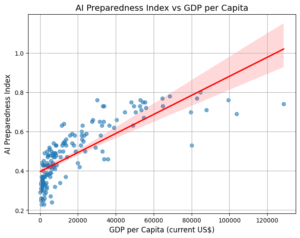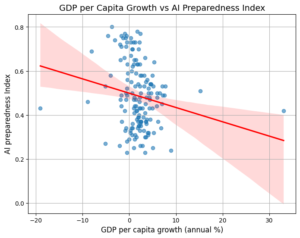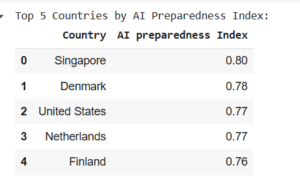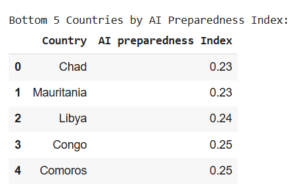
A booming economy doesn’t make a nation AI-ready — digital backbone, ethical foresight, and human skills do.
Beyond GDP: Identifying the True Drivers of National AI Preparedness
- May 5, 2025
- By Sagarika Chikhale
The global landscape of artificial intelligence (AI) preparedness reveals deep disparities among nations, shaped more by digital infrastructure, governance, and human capital than by economic growth alone. Understanding the key drivers behind AI readiness is crucial for narrowing this gap and ensuring inclusive technological progress. This study explores the relationship between the AI Preparedness Index (AIPI) and various enablers, including digital ecosystems, regulation and ethics, human capital development, innovation, and economic integration. Through comprehensive correlation analysis, it highlights how countries that balance technological advancement with strong governance, education, and innovation ecosystems are significantly better positioned to harness the benefits of AI.
Countries show wide disparities in AI preparedness, driven more by factors like digital infrastructure, regulation, and human capital than by economic growth alone. Understanding which capabilities most strongly influence AI readiness is essential for bridging this global gap.
APIP vs Digital Infrastructure
The analysis reveals critical insights into the relationship between a country’s digital infrastructure and its AI Preparedness Index (APIP). A very strong positive correlation of 0.96 between Digital Infrastructure and the AI Preparedness Index clearly indicates that countries with better-developed digital infrastructure are significantly more prepared to adopt and integrate artificial intelligence into their economies, societies, and governance systems. This finding highlights that a robust foundation of technological systems — including internet connectivity, server capacity, and general digital accessibility — is almost indispensable for enhancing a nation’s AI readiness.

However, when looking deeper into specific components of digital infrastructure, the strength of correlation varies. The correlation between APIP and the percentage of individuals using the internet stands at 0.75, which, although strong, is notably lower than the direct relationship with the overall AI Preparedness Index. This suggests that while widespread internet usage is important, it alone does not fully capture the technological maturity needed for AI adoption. In other words, simply having more internet users does not guarantee a country’s AI preparedness unless it is accompanied by broader digital advancements.
Further, the relationship between APIP and the number of Secure Internet Servers per million people shows an even weaker correlation of 0.46. This relatively moderate link indicates that while cybersecurity and server protection are crucial elements of a country’s digital environment, their direct impact on broad AI readiness might not be as immediate or dominant compared to other digital factors. It suggests that countries could still achieve strong overall AI preparedness even if their secure server density is not exceptionally high, provided that other digital infrastructure aspects are strong.
Overall, the analysis points to a clear conclusion, general digital infrastructure quality beyond just individual internet access or server security is a critical pillar for AI readiness. Building a broad and advanced technological environment contributes far more significantly to a country’s ability to successfully adopt AI than focusing narrowly on individual metrics.
AIPI vs Regulation and Ethics
The analysis highlights another critical dimension of AI readiness: the role of regulatory frameworks and ethical considerations. A very strong positive correlation of 0.94 between Regulation and Ethics and the AI Preparedness Index (AIPI) clearly establishes that countries with well-developed, responsible regulatory environments are significantly better positioned to adopt and integrate artificial intelligence technologies. This correlation is the second strongest observed after the relationship between Digital Infrastructure and AI Preparedness, underscoring that regulation is almost as foundational to AI readiness as technological capability.

The strength of this association suggests that merely having technological tools is not sufficient for advancing AI integration; a well-defined system of ethical guidelines, privacy protections, and governance structures is equally crucial. In the absence of proper regulation, even countries with strong digital infrastructure could struggle to integrate AI responsibly, risking issues such as data misuse, algorithmic bias, and public distrust. Therefore, countries that have invested effort into crafting comprehensive AI policies and ethical frameworks are naturally more prepared to leverage AI for societal and economic benefit.
This strong correlation also signals that global competitiveness in AI is not determined solely by technical advancement, but by a balanced approach where technology and governance advance hand-in-hand. Nations that have recognized and implemented such balanced strategies are clearly leading in AI preparedness, as evidenced by their high AIPI scores in relation to strong regulatory and ethical standards.
AIPI vs Human Capital and Labor Market Policies
The analysis further deepens the understanding of critical enablers behind a country’s AI preparedness. A very strong positive correlation of 0.91 between Human Capital and Labor Market Policies and the AI Preparedness Index (AIPI) confirms that a nation’s ability to nurture, educate, and skill its workforce plays a pivotal role in its readiness for AI adoption. This correlation is the third highest observed after Digital Infrastructure and Regulation and Ethics, emphasizing that technological advancement and regulatory strength must be matched with human capabilities to fully realize the potential of AI.

The strong relationship suggests that countries that prioritize education systems, continuous learning, AI-specific training, and adaptive labor market policies are substantially better prepared to integrate AI technologies effectively. The AI revolution not only demands technical talent such as engineers and data scientists but also a broader workforce that can interact with AI-driven systems across sectors. As such, investment in human capital ensures that societies are not just passive recipients of AI technologies but active participants in shaping and managing AI-enabled economies.
Moreover, the significant correlation also points to the critical importance of labor policies that support workforce transition during technological change. Policies that encourage reskilling, upskilling, and mobility across industries enable a smoother adaptation to the demands of an AI-driven future. Without a strong focus on human capital, even technologically advanced countries could face bottlenecks in AI deployment, highlighting why this pillar is so closely linked to overall AI preparedness.
AIPI vs Innovation and Economic Integration
The following graph provides valuable insight into the role of innovation capacity and economic integration in strengthening AI preparedness across countries. A very strong positive correlation of 0.88 between Innovation & Economic Integration and the AI Preparedness Index (AIPI) underlines that nations fostering innovation ecosystems and encouraging deeper economic interconnections are substantially better positioned to adopt and benefit from AI technologies. Although slightly lower than the correlations observed with Digital Infrastructure, Regulation and Ethics, and Human Capital, it still represents one of the strongest relationships influencing AI readiness.

This strong association suggests that the ability to create, adapt, and integrate new technologies within the economic framework is a crucial driver of AI preparedness. Countries with higher innovation capabilities such as strong research and development sectors, vibrant startup ecosystems, and effective industry-academia collaborations — are naturally more agile in responding to AI-related opportunities and challenges. Similarly, higher levels of economic integration, including international trade and participation in global technology markets, can accelerate the adoption and diffusion of AI innovations.
The data indicates that AI is not merely a technological upgrade but a dynamic force reshaping economies, requiring nations to remain competitive through continuous innovation and strategic economic engagement. Countries lagging in innovation capacity or economic openness may find themselves at a disadvantage, even if they have invested in infrastructure or human capital. Therefore, the strong link between Innovation & Economic Integration and AI preparedness highlights the importance of creating an environment where creativity, entrepreneurship, and global collaboration are actively encouraged and supported.
AI Preparedness Index vs GDP per Capita and GDP per Capita Growth
The following graphs bring an important economic perspective to the discussion of AI preparedness by exploring how national wealth and economic growth dynamics relate to the AI Preparedness Index (AIPI). The correlation between GDP per capita and AIPI stands at 0.79, indicating a strong positive relationship. This suggests that wealthier countries those with higher income per person tend to have better AI readiness. This connection aligns with expectations, as higher-income nations typically have greater financial resources to invest in digital infrastructure, regulatory systems, education, and innovation — all of which are directly tied to AI preparedness.
However, the relationship shifts noticeably when looking at GDP per capita growth, which has a weak and negative correlation of -0.19 with AIPI. This highlights a critical distinction: rapid economic growth does not necessarily translate to higher AI readiness. In many cases, lower-income or developing countries may be growing quickly in percentage terms but may still lack the mature infrastructure, governance frameworks, or skilled labor required to implement AI at scale. Therefore, while economic development is certainly important, the quality and structure of that development appear to matter more than the pace of growth when it comes to AI integration.
To add further depth to the analysis, the correlation of GDP per capita with other key AIPI components studied as shown in Table. This reinforces that national wealth positively influences the foundational capabilities required for AI readiness. These strong relationships suggest that wealthier nations are better positioned not only because of capital availability but because they can simultaneously build out multiple dimensions critical to AI deployment. However, the relatively lower correlations compared to AIPI’s direct relationships with these same factors indicate that economic prosperity alone does not guarantee AI preparedness — targeted policy and structural development remain essential.

Following Tables highlight a stark contrast in global AI readiness. Singapore, Denmark, and the United States lead the AI Preparedness Index (AIPI), reflecting strong infrastructure, regulatory maturity, and innovation capacity. These countries consistently perform well across key contributing factors. In contrast, Comoros, Congo, and Libya rank at the bottom, pointing to significant gaps in digital infrastructure, governance, and human capital. This sharp divide between the top and bottom performers underscores the global disparity in AI preparedness. It reflects how access to enabling conditions such as economic stability, regulatory maturity, and innovation ecosystems can significantly influence a country’s ability to embrace AI-driven transformation. The index, therefore, does not just highlight capabilities but also indirectly signals where policy, investment, and capacity-building efforts may be most urgently needed.
Next Steps:
• Strengthening Comprehensive Digital Infrastructure, Not Just Internet Access
Governments must invest broadly in national digital ecosystems, including high-speed internet, cloud computing capacity, data centers, cybersecurity, and server infrastructure. As the analysis showed that overall digital maturity (correlation 0.96) is far more important than just internet usage (0.75) or server security (0.46). Isolated improvements won’t meaningfully boost AI preparedness without an integrated digital foundation.
• Develop and Enforce Robust AI Regulations and Ethical Frameworks
Countries should prioritize creating clear AI governance policies covering data privacy, algorithmic transparency, accountability, and ethical AI use. Regulation and Ethics (correlation 0.94) are almost equally critical as digital infrastructure. Without strong governance, technological capabilities alone risk backfiring through public distrust, legal challenges, and ethical failures.
• Invest Heavily in Human Capital Development with AI-Specific Focus
Expand AI-focused education, vocational training, and lifelong learning initiatives. Focus on both technical (e.g., AI engineers, data scientists) and non-technical (e.g., policymakers, business leaders) skill development. Human capital and labor policies (correlation 0.91) directly impact readiness. Having a workforce capable of working with and adapting to AI is as important as having the technology itself.
• Build National Innovation Ecosystems and Boost Global Economic Integration
Support R&D initiatives, encourage startup ecosystems, strengthen university-industry collaborations, and participate actively in international technology markets. Innovation and economic integration (correlation 0.88) drive AI readiness. Economies that innovate and connect globally are better positioned to adapt AI technologies quickly and competitively.
• Targeted Investment is More Critical than GDP Growth Alone
Policymakers in both wealthy and rapidly growing economies must direct investments specifically into digital infrastructure, governance frameworks, education, and innovation — instead of relying solely on economic growth. As GDP per capita (correlation 0.79) supports AI readiness, but GDP growth alone (-0.19 correlation) does not. Smart, targeted development matters far more than raw growth speed.
• Prioritize Capacity Building in Lower-Prepared Nations
International organizations and leading countries should support capacity-building programs focusing on digital infrastructure, governance, education, and innovation in low-prepared nations (e.g., Comoros, Congo, Libya). As shown previously a stark divide in AI readiness globally. Addressing the gaps early can prevent deepening technological inequalities and foster more inclusive global AI development.
• Adopt a Balanced Policy Approach: Technology, Governance, Skills, and Innovation Together
Countries must not treat AI readiness as a purely technological issue. A coordinated policy combining digital advancement, regulation, human capital, and innovation is essential. The analysis clearly showed that no single pillar is sufficient. Successful AI integration demands simultaneous, balanced progress across all enabling conditions.






